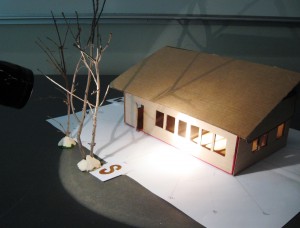Engineering to do Nothing

Originally appears in the Winter 2016 issue
Most teachers turn the lights off after students leave the classroom. I turn the lights off when students come in.
I always ask, “Can everyone still see well enough to read, write, and work on a project?”
“Yes!”
“We’re already conserving energy, thanks to the Sun!”
So we begin learning with the lights off, but not in the dark.
Teaching children about living more sustainably with the environment often focuses on conserving resources and habitats. But looking at this issue deeper, we might consider why the human landscape demands so many resources from natural landscapes in the first place. A lifestyle devoted to the accumulation of “stuff” is certainly a factor. However, no matter your lifestyle, even the buildings where we live, learn, work, and play are often resource intensive by design. Any strategy to live or teach the next generation about living more sustainably should involve how to redesign our built environment to provide the desired results.
Although the residential sector consumes less energy than do industry and transportation, children most readily connect with the places where they live. While a lot of attention is being put on increasing the amount of energy derived from renewable resources such as solar, wind, water, it can be expensive to outfit a classroom with enough solar cells, turbine kits, and multimeters for a worthwhile hands-on experience. And of course, each alternative energy technology carries its own issues; including siting, low efficiencies, and wildlife impacts.
Conservation habits can go a long way in cutting energy needs (and bills!) for a family, but passive solar design can enable upper elementary and middle school students to take up the challenge of designing an energy efficient home which requires less input from any active energy source. In the following paragraphs I outline how you can have your students investigate the energy principles associated with passive solar design using simple shoebox models and flashlights.
To view the photo-rich magazine version, click here.
If you are not already a subscriber, please subscribe to read the full article
Susan Lewicki is the senior Environmental Educator for the Meadowlands Environment Center in northeastern New Jersey. She has over 20 years of experience developing and leading hands-on field trips for K-12 students and community groups, as well as standards- and place-based teacher workshops.
Resources
Gould, Alan. Hot Water and Warm Homes from Sunlight. Teacher’s Guide. GEMS c/o Lawrence Hall of Science, University of California, Berkeley, 1995.
Gould, Alan, Willard, Carolyn, Pompea, Stephen. The Real Reasons for Seasons: Sun-Earth Connections, Grades 6-8. GEMS c/o Lawrence Hall of Science, University of California, Berkeley, 2000.
Fraknoi, Andrew, editor. The Universe at Your Fingertips 2.0 DVD-ROM. Astronomical Society of the Pacific, 2011.
Notes
[i] SunPosition, “SunPosition Calculator” http://sunposition.info/sunposition/spc/locations.php
Leave a Reply
You must be logged in to post a comment.





